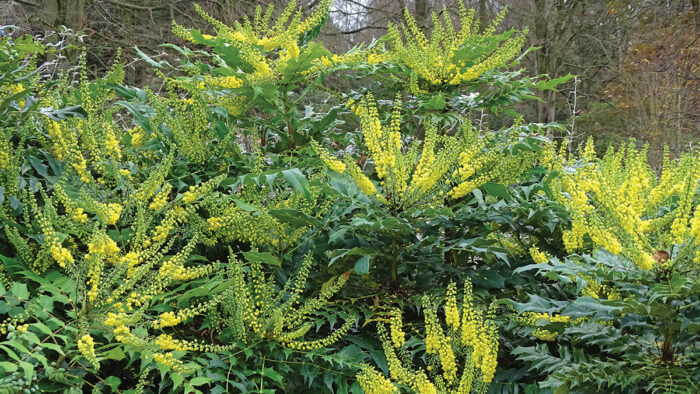
1. Chinese Kousa Dogwood

Name: Cornus kousa var. chinensis
Zones: 5–8
Size: 15 to 30 feet tall and 12 to 25 feet wide
Conditions: Full sun to partial shade; moderately moist, well-drained soil
Native range: China
Flowering dogwoods are among the most beautiful trees you can grow, and this variety is no exception. Chinese kousa dogwood is the last of the showy dogwoods to bloom, with the buds emerging lime green in late May to early June and then opening milky white as the attractive bracts mature. This tree can bloom for up to four weeks if the weather doesn’t get too hot. As the flowers fade, they often take on a blush of pink. In late summer, red cherry-like fruit hangs from the branches. Flowering can be lighter in dappled shade, but the graceful, layered branch structure will be more pronounced. Chinese kousa dogwood has great fall color and excellent disease tolerance.
2. Yellowroot

Name: Xanthorhiza simplicissima
Zones: 3–9
Size: 1 to 3 feet tall and 6 to 10 feet wide
Conditions: Full sun to partial shade; moist, well-drained soil
Native range: Eastern United States
The spreading habit of yellowroot makes it an unusual and interesting ground cover for West Coast gardens. In mid-spring, the thin, upright stems hold clustered chains of tiny, burgundy, star-shaped flowers that warrant a closer inspection. The leaves are composed of small, lacy leaflets that are shiny and bright green in summer, later erupting into a melange of purple, orange, and yellow in fall. This is one of the few plants that will provide good autumn color even if it is grown in shade. Broken or cut stems reveal mustard-yellow interiors that are surprisingly brilliant.
3. ‘Tansu’ Dwarf Japanese Cedar

Name: Cryptomeria japonica ‘Tansu’
Zones: 6–9
Size: 3 feet tall and wide in 10 years
Conditions: Full sun to full shade; fertile, well-drained soil
Native range: Japan
I was first drawn to this dwarf conifer by its tight, dark green foliage and the way its growth reminded me of cresting ocean waves. There are two planted at the Miller Garden—one in bright open shade on a dry slope and the other in a dry, heavily shaded location. In both spots they have thrived over the last four decades, putting on about 2 to 4 inches of growth per year. The leaves are small, awl-shaped scales that can be a little prickly to the touch. Fortunately, this evergreen needs almost no pruning to look its best. It is drought tolerant once established but appreciates occasional watering in full sun during the summer.
4. ‘Winter Sun’ Mahonia

Name: Mahonia × media ‘Winter Sun’
Zones: 7–9
Size: 6 to 8 feet tall and 3 to 4 feet wide in 10 years
Conditions: Full sun to partial shade; well-drained soil
Native range: Hybrid
There is a trend to classify mahonias as barberries (Berberis spp. and cvs.), but there is compelling research that supports the separation of these two genera. No matter what you call the plant, however, it is a must-have for the garden. Few evergreen shrubs can rival the architectural beauty of ‘Winter Sun’. It is one of the very best mahonia cultivars, with its strong, upright growth and stiff horizontal leaves giving it a stately presence. In late fall to early winter, abundant, brassy yellow racemes of flowers arch out over the deep green foliage. Overwintering Anna’s hummingbirds find the nectar-rich, fragrant blooms irresistible and will fiercely protect their favorite shrubs. ‘Winter Sun’ appreciates occasional water during dry periods.
Richie Steffen is a contributing editor and the executive director of the Elisabeth C. Miller Botanical Garden in Seattle.


















Comments
Log in or create an account to post a comment.
Sign up Log in